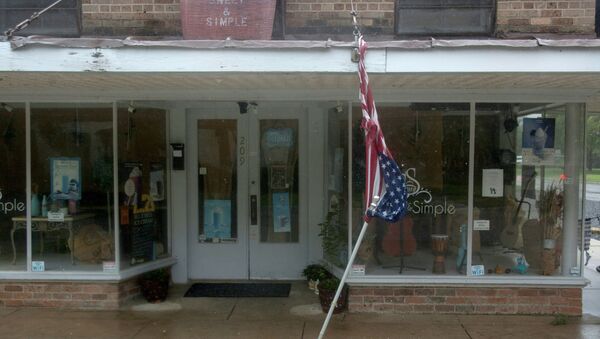Dubbed "Hurricane Barry", a category 1 hurricane reaching up to 75 mph (120 km/h) winds made landfall around 1pm on Saturday and is sweeping across Louisiana.
As the storm began with overnight showers and significant winds, some motorists still managed to brave the weather in spite of warnings of 20 inches (50 centimetres) of rain.
Upon landfall, it was significantly weaker than expected and reduced to a tropical storm, but still resulted in flooding throughout the coast along the Gulf of Mexico.
Around 10 am, the storm was approximately 50 miles (80 km) away from the US coast.
Powerful winds toppling power lines, and 'life-threatening' flooding soon followed throughout the day.
This is a tropical storm "Barry" in Louisiana USA right now 😮😮 pic.twitter.com/y0XDD2svqX
— Best of Aliexpress and China (@coolstuffcheap) July 12, 2019
The impact was first felt in Morgan City near New Orleans, among warnings of storms hitting cities on the coast followed by tornadoes in neighbouring Mississippi.
New Orleans airport also saw state-wide cancellations of all major flights in and out of the city on Saturday and has now reported that Barry will leave 2 ft (60 cm) of rain over the period of the next 2 days.
Barry is the first hurricane to hit the US mainland in 2019 during the Atlantic hurricane season. It is not, however, the first tropical storm of year, as Tropical Storm Andrea hit the Atlantic in May.
At least 1 hurricane has hit the US for 4 consecutive years and the Mississippi river has reached the highest point it has ever been during a storm of this size, as reported by ABC.
However, authorities have said that the Mississippi River is unlikely to flood over the levees protecting the city of New Orleans.
Ken Graham, the director of the National Hurricane Center, used Facebook Live to broadcast the storm, pointing to a large screen where a huge swirling mass of airborne water was projected while declaring that the storm was "off the chart".
The hurricane is currently moving at such a slow pace that a heavy downpour is likely to continue across Louisiana throughout the weekend.
He warned that "a lot of rain is on the way" as Barry gathers "a big slough of moisture" which was predicted to hit from Saturday morning and last until the afternoon.
He reminded broadcast viewers that "83 percent" of fatalities during a hurricane come from inland rain and advised people to stay off the roads.
NEW: flooded Atchafalaya River from stop the levee at Morgan City, LA with big waves coming in from the south with storm surge of Tropical Storm Barry @breakingweather @accuweather pic.twitter.com/lGlRwADBot
— Reed Timmer (@ReedTimmerAccu) July 13, 2019
Over 300 people ran to shelters upon the arrival of the hurricane, according to Marketa Garner-Walters, the secretary of the Louisiana Department of Children and Family Services.
As the southeast prepares for Tropical Storm Barry’s impact, the Red Cross here in East Tenn. is holding classes to sign up new volunteers. They’re planning to send around 20 volunteers, some already in Louisiana, some leaving tomorrow. They are focusing primarily on shelters. pic.twitter.com/YDHPqNMsZd
— Ashley Sharp (@AshleySharpWJHL) July 13, 2019
While there have been no evacuations in New Orleans itself, an extra 10,000 people in low lying and flood-vulnerable areas were ordered to leave their homes by authorities.
Tourists and other party-goers did not let the warnings from Mayor LaToya Cantrell ruin their experience as they drank flood-cocktails on Bourbon Street on Friday night.
French Quarter in New Orleans prepares for Tropical Storm Barry but there is still a party on Bourbon Street. Curfew is 8 p.m. pic.twitter.com/oQEFm8Z9E6
— Jake Crandall (@jakevcrandall) July 13, 2019
An evacuation order was also issued for all areas along both Brady Road and Highway 315 on Saturday afternoon.
2:09pm
— Nathan Robert (@myUNTed) July 13, 2019
Parish President
Gordon Dove@TOHSEP says that
EFFECTIVE IMMEDIATELY MANDATORY EVACUATION NOTICE has been issued for all areas long LA Hwy 315 and Brady Road below or south of Falgout Canalhttps://t.co/Vnod2V6gdE
Need transportation assistance number located on order pic.twitter.com/0vsSeAUVvz
Business owners and residents laid down flood prevention materials such as sandbags.
New Orleans Residents Fill Hundreds of Sandbags Ahead of Tropical Storm Barry https://t.co/FpNfNjKsKP
— tiym.ryvt@gmail.com (@tiymryvt1) July 12, 2019
This is the first time all floodgates have been closed in the New Orleans-area under the Hurricane Risk Reduction System since Katrina, according to Governor John Bel Edwards.
The Governer took to twitter to say that "No one should take this storm lightly".
No one should take this storm lightly, and I urge everyone to remain informed and aware as #TropicalStormBarry makes landfall along our coast. For a comprehensive list of up to date information and disaster resources, visit: https://t.co/xpXhbYAXas#lagov #lawx #Barry pic.twitter.com/xRBvBZRC6o
— John Bel Edwards (@LouisianaGov) July 12, 2019
More than 70,000 to 100,000 customers have been left without power throughout the Terrabonne, Assumption, East Baton Rouge, Jefferson, and Lafourch parishes according to Entergy Louisiana.
Sitting in this house, riding through tropical storm Barry. No lights/power and the heat inside will kind of rise a bit. Thank God for babies and other supplies.
— Jared Degruise (@JaredDegruise) July 13, 2019
Around 300 National Guard troops and rescue teams have been stationed around Louisiana with boats, high-water vehicles and helicopters.
President Donald Trump declared a federal emergency for Louisiana, including federal agencies in the coordination of relief efforts.
Total economic losses are estimated to reach $8 to $10 billion, according to estimates by AccuWeather.
The cost also includes damage to homes and businesses, as well as cars, agricultural damage, contamination of drinking water, and general damage to infrastructure.


